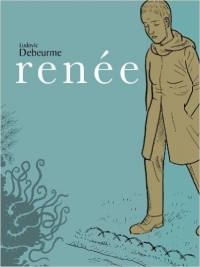Renée by Ludovic Debeurme
 Monday, March 21, 2016 at 8:31AM
Monday, March 21, 2016 at 8:31AM 
First published in France in 2011; published in translation Top Shelf Productions on February 23, 2016
Renée is a graphic novel with the feel of a sketchbook. The art is minimalist, as is the text. Backgrounds are nearly nonexistent. Some pages are blank. When words appear, they often make an arc across the page. Sometimes the words are intended as dialog, sometimes they are narrative monologue spoken by an unseen character, and sometimes the origin of the words is unclear. Frequently, wordless sequences of five or ten sketches end up with characters curling up into balls.
Renée is a sequel to the author’s Lucille. The characters who appear in Renée are trapped in depressive states, often with good reason. Arthur, who killed Lucille’s attempted rapist in the first novel, is in prison, sharing a cell with Eddie, who accidentally caused the death of a fisherman with whom he was fighting. The others are figuratively imprisoned by the lives they have made for themselves. Renée is seeing Pierre, a married man twice her age who can’t choose between the two women. Lucille is living in a claustrophobic relationship with her mother, a woman she loves and hates in equally stifling degrees.
After Eddie gains his freedom (and, thanks to Arthur’s decency, finds a place to live), Arthur gets a new cellmate who is suspected of being a child molester. The experience changes Arthur and (for reasons I won’t reveal here) eventually causes Lucille and Renée to meet and bond.
The story has surprising depth, given the minimalist nature of the storytelling. Some of the scenes are surrealistic, including a scene in which people crawl out of the cuts that Renée has made in her arms. In a dream sequence, Arthur grows wings and, as an insect, flies out of prison to nest comfortably in Lucille’s hair. Characters enlarge or shrink or parts of their bodies change or they morph into embodiments of ugliness. I’m sure there’s a fair amount of symbolism here that I’m not quite grasping, although I suspect the illustrations stray into the territory of fantasy to express how the characters are feeling at the moment.
Some of Ludovic Debeurme’s illustrations are grotesque but none should be particularly upsetting to readers who are not easily upset. The text, on the other hand, describes events that include rape and incest, topics that might be disturbing to sensitive readers. Those events are not gratuitous; they are necessary to understand the states of mind and stages of life that the characters experience.
The beginning of Renée is confusing. The story is not always told in linear time and recognizing characters can be a challenge, given how their appearances change. The story requires the reader’s effort but by the end, everything falls into place. The ending is left open, with two characters sailing away in search of more answers, or to start another chapter in their lives. Perhaps the intent is for another volume to continue the story, but the ending may simply be meant to remind readers that our own stories never end until we die -- there is always something new, something unexpected, perhaps even something pleasant, awaiting our discovery.
RECOMMENDED
Reader Comments